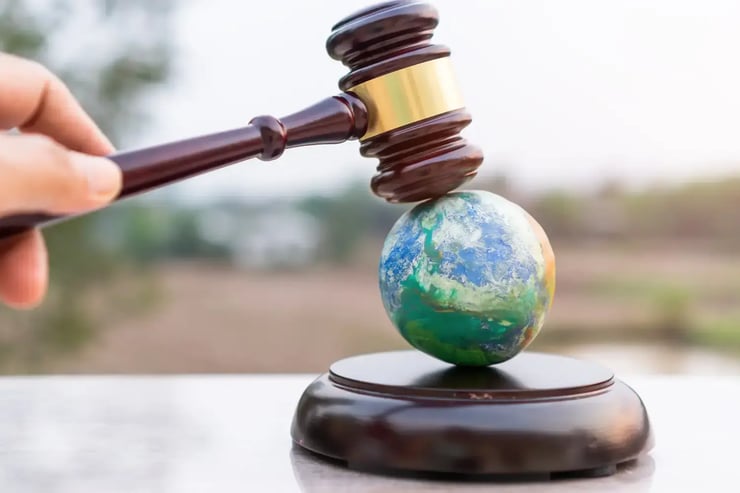5 min read
The Inflation Reduction Act and Environmental Justice Grants
![]() Transect Team
:
Feb 24, 2023
Transect Team
:
Feb 24, 2023

Listen to the audio version
Signed into law by President Joe Biden on August 16, 2022, the IRA directs federal spending toward cutting domestic carbon emissions by about 40% by 2030 and provides tax credits for zero-carbon energy production, among other things. In the last six months since the Biden Administration signed the historic Act into law, more than 100,000 clean energy jobs have been created, according to the nonprofit Climate Power in its most recent Clean Energy Boom report.
You may know by now that the President's State of the Union address took place this week in the U.S. Capitol's House chamber. If you didn't already know this, it’s okay. There’s been a LOT to keep up with in the world lately. From balloons in the sky to Rihanna’s Super Bowl performance, our attention is pretty much completely taken right now.
Anyway, there's a point to this. More like commentary, I suppose. A handful of members of Congress are threatening to repeal the Inflation Reduction Act (to that, I say good luck.)
The $100 million in grants is set to go towards projects that advance environmental justice in underserved and overburdened communities. These communities are historically overburdened by water and air pollution, high energy costs, and a lack of affordable housing. These grants aim to tackle climate challenges while creating jobs and following through on delivering energy security.
According to the Environmental Protection Agency (EPA), the IRA's grant programs further President Biden's Justice40 Initiative and Executive Order (Tackling the Climate Crisis at Home and Abroad)," which directed that 40% of the overall benefits of certain federal investments go to overburdened communities that face disproportionately high and adverse health and environmental impacts."
But what about these block grants, you may ask? More on that in a second. Didn't your mom ever tell you at the dinner table to save the best thing on your plate for last? No, just me? Okay, well, anyway.
Environmental Justice: The Earth Held a Protest?
A brief note from the author: Before we continue to explain how YOU could have access to this *Bob Barker Voice* BRAND NEW GRANNNTTT, we have to explain what exactly environmental justice is.
Environmental Justice is a social movement that aims to combat environmental inequality because communities of color are disproportionately forced to bear unequal environmental and economic burdens like poor water and air quality. EJ rightfully suggests that all people have a legal and equal right to environmental protection and to live, attend school, play outside, and work in communities that are safe and free of the harms caused by unhealthy conditions. Who would have thought that access to clean air was something we could disagree on…
EJ is an evolving concept that does not align with one specific legal definition that currently serves as the frontline defense against energy inequality. Still, according to the EPA, “Environmental justice is the fair treatment and meaningful involvement of all people regardless of race, color, national origin, or income with respect to the development, implementation and enforcement of environmental laws, regulations and policies.”
So now that we have a definition for EJ, you may wonder how this goes hand-in-hand with the IRA. And surprise, we are here to tell you. In our recent blog, Environmental Justice and the IRA, we discuss how the IRA improved prospects for EJ. But here’s a snapshot: the IRA includes roughly $47 billion in EJ-specific provisions to remediate existing hazards and improve the environmental health of underserved communities. This money is directed towards cleaning up Superfund sites, mitigation efforts for greenhouse gas emissions reduction, expanding transportation access in low-income communities, electrification projects in public housing and helping federal agencies implement NEPA reviews.
Pretty good trailer to the whole shebang, right? Moving on! Next up: the EJ grants.
Environmental Justice Grants
The grants proceed through two funding programs through the federal government: The Environmental Justice Collaborative Problem-Solving Program (EJCPS) Cooperative Agreement Program and the Environmental Justice Government-to-Government (EJG2G) Program. That’s a mouthful, but stay with me.
The EJCPS Program “provides financial assistance to eligible organizations working or planning to work on projects and develop solutions to combat local environmental and/or public health issues.” This program allocates an estimated $30 million in funding directly to community-based nonprofit organizations and corresponding partnerships of these organizations, and $5 million is reserved for small community-based nonprofit organizations with five or fewer full-time employees. The EPA plans to fund approximately 50 awards of $500,000 and 30 awards of $150,000.
The EJG2G Program “provides funding at the state, local, territorial, and tribal levels to support or create model government initiatives that lead to identifiable public health or environmental impacts in communities overburdened by environmental hazards.” This program provides an estimated $70 million in funding, whereas $20 million is reserved for State governments to use in conjunction with Community-Based Organizations (CBO) partners, $20 million for location government with CBO partners, $20 million for Federally Recognized Tribal Nations with CBO partners and $10 million for U.S. territories and remote tribes with limited access to CBO partners. The EPA plans to fund approximately 70 projects of up to $1 million each for a 3-year project.
Under both programs, the EPA will be giving special consideration to projects under these specific focus areas:
-
Projects addressing climate change, disaster resiliency, and/or emergency preparedness
-
Projects located in and/or benefitting rural areas
-
Projects conducting Health Impact Assessments (HIA), a decision-making tool used by the EPA to promote sustainable and healthy communities.
All interested applicants must submit proposals on or before April 10, 2023, with projects set to begin on October 1, 2023.

Let's Take It Back: Recap Time
So where does that leave us where solar and renewable development is concerned? Great question! But in short and according to Reuters, many of the green energy incentives in the IRA reflect proposals presented in the Build Back Better Act, which failed to go anywhere outside of Congress in 2021. But here is where the IRA lands (ha, pun intended):
-
The existing 30% investment tax credit (ITC) for solar, qualified fuel cells, waste energy recovery, geothermal and other electricity generation facilities extends through 2024.
-
Existing production tax credit (PTC) for wind, biomass, landfill gas, trash, qualified hydropower and other electricity generation facilities will be extended through 2024.
-
Additional ITC and PTC for projects that are in “energy communities,” like low-income communities and Indian land.
-
Extension of the ITC to standalone energy storage facilities like batteries.
-
Two new tax credits for projects in service (like battery energy storage) after 2024, including the Clean Electricity Investment Credit and the Clean Electricity Production Credit.
-
Wage and apprenticeship requirements to qualify for the full 30% ITC and PTC (adjusted for inflation).
-
Extension and addition of new tax credits related to carbon oxide sequestration facilities, zero-emission nuclear power production facilities, biodiesel, renewable diesel, clean hydrogen production, advanced energy projects, advanced manufacturing of qualifying renewable energy projects and alternative refueling property.
These incentives help land developers get more green energy projects going out the door. We can see wider access to these energy types as we create more renewable energy projects using these incentives. These incentives will support efforts to make clean air and water more accessible. Additionally, the creation of jobs in this sector provides more opportunities for community-wide growth.
So What's the Big Deal?
The IRA is transformational in its comprehensive approach to fighting climate change, investing $369 billion in climate-related programs and incentivizing approaches that will enhance our ability to reduce carbon emissions by 2030. And let’s not forget the IRA provides strong fiscal incentives that developers can leverage to make projects more cost-effective. While the IRA is singlehandedly accelerating a clean energy boom, fear not the impending state of our economy because it seems the IRA is working to create a handful of new clean energy investment opportunities. With grants and rebates available to fund developers and community-led projects alike, it seems climate action will continue to press on, serving people from all walks of life.
To reach climate resilience, we will need more than a few Americans switching over from fossil fuels to electric vehicles. We will need massive projects, the technical assistance to perfect clean energy tools, and support from the white house down to the local level to ensure no one gets left behind during progress. Supporting our climate goals is more than protecting endangered ecosystems and pollution monitoring; it is about protecting each other and moving forward together. We look forward to the projects these grants will create.

